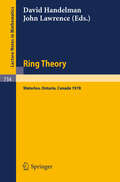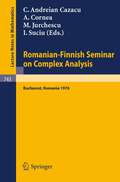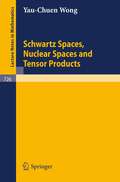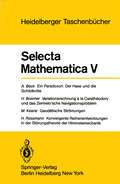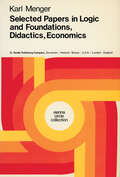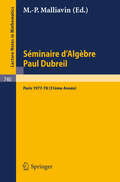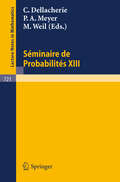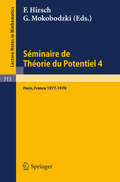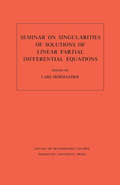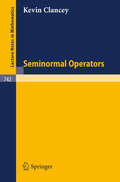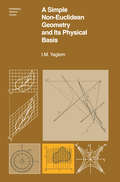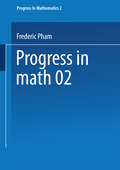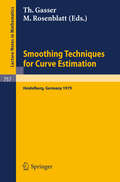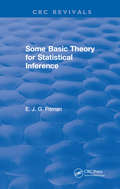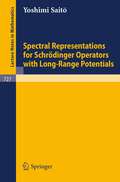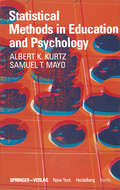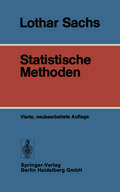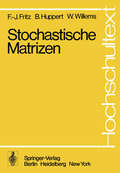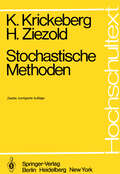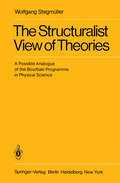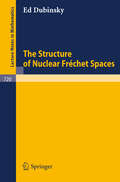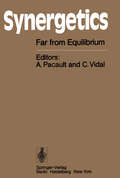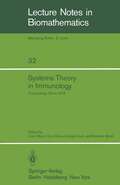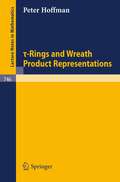- Table View
- List View
Ring Theory, Waterloo 1978: Proceedings, University of Waterloo, Canada, 12-16 June, 1978 (Lecture Notes in Mathematics #734)
by D. Handelman J. LawrenceRomanian-Finnish Seminar on Complex Analysis: Proceedings, Bucharest, Romania, June 27 - July 2, 1976 (Lecture Notes in Mathematics #743)
by C. Cazacu A. Cornea M. Jurchescu I. SuciuSchwartz Spaces, Nuclear Spaces and Tensor Products (Lecture Notes in Mathematics #726)
by Y.-C. WongSelecta Mathematica V: Ein Paradoxon, der Hase und die Schildkröte. Variationsrechnung a la Caratheodory und das Zermelo'sche Navigationsproblem. Geodätische Strömungen. Konvergente Reihenentwicklungen in der Störungstheorie der Himmelsmechanik (Heidelberger Taschenbücher #201)
by A. Beck H. Boerner M. Keane H. RüssmannDie im vorliegenden fünften Selecta-Band zusammengefaßten Beiträge behandeln Themen, die etwa durch die Stichworte "Bewegung, Strömung, Mechanik" zu umreißen sind. Zu jedem Beitrag gehört eine Vorgeschichte, die ihn mit berühmten alten Problemstellungen verbindet. Fährt man von Neapel aus nach Süden über Paestum hinaus die lukanische Küste entlang, so kommt man nach etwa einer Stunde zu den ausgegrabenen Ruinen der alten griechischen Stadt Elea (gegr. 540 v. ehr. ), in der die Philosophen Parmenides (ca. 510 - ca. 440 v. ehr. ) und Zenon (ca. 490 - ca. 430 v. ehr. ) gewirkt haben. Von den vier sog. Paradoxien des Zenon (sie sind in der Physik des Aristoteles überliefert und kommentiert) gehören drei zum allgemeinen Gesprächsstoff der sog. Gebildeten: 1. Man kann nicht gehen, denn um ein Stadion zurückzulegen, muß man erst ein halbes Stadion zurücklegen, dazu vorher ein Viertelstadion usw. , ein unendliches Pensum, das man nicht bewältigen kann. 2. Achilles kann die Schild kröte nicht überholen, denn er muß erst einmal deren Start punkt erreichen, dann ist sie aber schon zu einem neuen Punkt vorgerückt, den Achilles als nächstes besuchen muß etc. , wieder ein unendliches und folglich nicht zu bewältigendes Pensum für den armen Helden. 3. Der abgeschossene Pfeil bleibt in der Luft stehen, denn aus den in 1. genannten Gründen kann er keine positive Strecke zurücklegen.
Selected Papers in Logic and Foundations, Didactics, Economics (Vienna Circle Collection #10)
by Karl MengerThis volume brings together those papers of mine which may be of interest not only to various specialists but also to philosophers. Many of my writings in mathematics were motivated by epistemological considerations; some papers originated in the critique of certain views that at one time dominated the discussions of the Vienna Cirele; others grew out of problems in teaching fundamental ideas of mathematics; sti II others were occasioned by personal relations with economists. Hence a wide range of subjects will be discussed: epistemology, logic, basic concepts of pure and applied mathematics, philosophical ideas resulting from geometric studies, mathematical didactics and, finally, economics. The papers also span a period of more than fifty years. What unifies the various parts of the book is the spirit of searching for the elarification of basic concepts and methods and of articulating hidden ideas and tacit procedures. Part 1 ineludes papers published about 1930 which expound an idea that Carnap, after a short period of opposition in the Cirele, fully adopted ; and, under the name "Princip/e of To/erance", he eloquently formulated it in great generality in his book, Logica/ Syntax of Language (1934), through which it was widely disseminated. "The New Logic" in Chapter 1 furthermore ineludes the first report (I932) to a larger public of Godel's epochal discovery presented among the great logic results of ali time. Chapter 2 is a translation of an often quoted 1930 paper presenting a detailed exposition and critique of intuitionism.
Séminaire d'Algèbre Paul Dubreil: Proceedings. Paris 1977-78 (31ème Année) (Lecture Notes in Mathematics #740)
by M. P. MalliavinAvec des contributions de nombreux expertes
Séminaire de Probabilités XIII: Université de Strasbourg 1977/78 (Lecture Notes in Mathematics #721)
by C. Dellacherie P. A. Meyer M. WeilSéminaire de Théorie du Potentiel Paris, 1977-1978, No. 4 (Lecture Notes in Mathematics #713)
by M. Brelot F. Hirsch G. Choquet G. Mokobodzki J. DenySeminar on Singularities of Solutions of Linear Partial Differential Equations. (AM-91), Volume 91
by Lars HörmanderSingularities of solutions of differential equations forms the common theme of these papers taken from a seminar held at the Institute for Advanced Study in Princeton in 1977-1978. While some of the lectures were devoted to the analysis of singularities, others focused on applications in spectral theory. As an introduction to the subject, this volume treats current research in the field in such a way that it can be studied with profit by the non-specialist.
A Simple Non-Euclidean Geometry and Its Physical Basis: An Elementary Account of Galilean Geometry and the Galilean Principle of Relativity (Heidelberg Science Library)
by I.M. YaglomThere are many technical and popular accounts, both in Russian and in other languages, of the non-Euclidean geometry of Lobachevsky and Bolyai, a few of which are listed in the Bibliography. This geometry, also called hyperbolic geometry, is part of the required subject matter of many mathematics departments in universities and teachers' colleges-a reflec tion of the view that familiarity with the elements of hyperbolic geometry is a useful part of the background of future high school teachers. Much attention is paid to hyperbolic geometry by school mathematics clubs. Some mathematicians and educators concerned with reform of the high school curriculum believe that the required part of the curriculum should include elements of hyperbolic geometry, and that the optional part of the curriculum should include a topic related to hyperbolic geometry. I The broad interest in hyperbolic geometry is not surprising. This interest has little to do with mathematical and scientific applications of hyperbolic geometry, since the applications (for instance, in the theory of automorphic functions) are rather specialized, and are likely to be encountered by very few of the many students who conscientiously study (and then present to examiners) the definition of parallels in hyperbolic geometry and the special features of configurations of lines in the hyperbolic plane. The principal reason for the interest in hyperbolic geometry is the important fact of "non-uniqueness" of geometry; of the existence of many geometric systems.
Singularités des systèmes différentiels de Gauss-Manin (Progress in Mathematics #2)
by Frédéric PhamSmoothing Techniques for Curve Estimation: Proceedings of a Workshop held in Heidelberg, April 2-4, 1979 (Lecture Notes in Mathematics #757)
by T. Gasser M. RosenblattSome Basic Theory for Statistical Inference: Monographs on Applied Probability and Statistics
by E.J.G. PitmanIn this book the author presents with elegance and precision some of the basic mathematical theory required for statistical inference at a level which will make it readable by most students of statistics.
Some Basic Theory for Statistical Inference: Monographs on Applied Probability and Statistics
by E.J.G. PitmanIn this book the author presents with elegance and precision some of the basic mathematical theory required for statistical inference at a level which will make it readable by most students of statistics.
Spectral Representations for Schrödinger Operators with Long-Range Potentials (Lecture Notes in Mathematics #727)
by Yoshimi SaitoStatistical Methods in Education and Psychology
by A.K. Kurtz S.T. MayoThis book is intended for use in the elementary statistics course in Educa tion or in Psychology. While it is primarily designed for use in the first semester of a two-semester course, it may also be used in a one-semester course. There are not five or ten competing texts; the number is much closer to fifty or a hundred. Why, then, should we write still another one? A new statistics text for use in Education and Psychology is, to some slight extent, comparable to a new translation or edition of the Bible. Most of it has been said before-but this time with a difference. The present writers realize that elementary statistics students know very little about the subject-even the meaning of I is all Greek to them. This text covers the basic course in depth, with examples using real data from the real world. It, of course, contains the usual reference tables and several new ones; it gives the appropriate formulas every time; and it accurately depicts all graphs. It is so comprehensive that if instructors can't find their own special areas of interest covered, then those interests probably don't belong in a basic text.
Stochastische Matrizen (Hochschultext)
by F.-J. Fritz B. Huppert W. WillemsIn der Anfängervorlesung "Lineare Algebra" lernt der Student ein umfang reiches System von Begriffen und Ergebnissen kennen. Auf die Bedeutung dieser Theorie für die ganz"e t1athematik wird er zwar oft hingewiesen, aber vorgeführt werden meist nur Anwendungen aus der Geometrie. Das vorliegende kleine Heft ist äer Versuch, ein anderes Gebiet für die Motivierung der Anfängervorlesung zu erschließen, nämlich die Theorie der stochastischen Prozesse mit endl~ch vielen Zuständen in matrizen theoretischer Behandlung. Unsere Darstellung steht zwischen den sehr elementar gehaltenen Büchern (mitunter mit dem Titel "Finite Mathema tics"), die zum Teil für Nichtmathematiker geschrieben sind und nur Elemente der Linearen Algebra verwenden, und den allgemeinen Theorien der stochastischen Prozesse, welche dem endlichen Spezialfall oft wenig Raum widmen. Sie stützt sich weitgehend auf die Betrachtung der Eigen werte von stochastischen Matrizen. Obwohl die Bestimmung der Eigenwerte nicht direkt ein Teil des Problems ist, scheint uns das Studium der Eigenwerte den besten Aufschluß über das Verhalten der Potenzen einer stochastischen Matrix zu geben. (Wir sind uns dessen bewußt, daß diese Methode freilich für stochastische Prozesse mit unendlich vielen Zustän den völlig versagt. ) Nach der Erörterung der Problemstellung und einigen Beispielen in § 1 werden in § 2 alle später benötigten Aussagen über die Eigenwerte von stochastischen Matrizen hergeleitet. Darauf folgen dann in § 3 leicht die Konvergenzsätze. In § 4 behandeln wir weitere Sätze über die Eigen werte von stochastischen Matrizen, die jedoch später kaum mehr verwen det werden.
The Structuralist View of Theories: A Possible Analogue of the Bourbaki Programme in Physical Science
by Wolfgang StegmüllerThe present text originated with the intention of writing a brief reply to Feyerabend's detailed discussion of my book The Structure and Dynamics of Theories. For reasons explained in the Introduction this turned out to be an impossible undertaking. What resulted was a self-contained new approach to the structuralist view, combined with an attempt to bring it up to date by including a report on the latest developments. As matters stand it would have been unreasonable and unfair of me to ask the editors of The British Journal for the Philosophy of Science to publish this text which exceeds by far the size of an average essay. Thus, a separate publication seemed advisable. I am deeply indebted to Springer-Verlag for making this publication possible. Since the publication of the above-mentioned book I have learned a lot from the works, partly unpublished, of Professor Joseph D. Sneed, Professor Carlos Ulises Moulines, and Dr. Wolfgang Balzer. I should like to thank my co-workers Dr. Wolfgang Balzer and Dr. Matthias Varga von Kibed and my student Michael Heidelberger for many constructive, critical remarks on the first draft of the manuscript and, in addition, Dr. Balzer for collecting and orga nizing the material for the Formal Appendix. Last, but not least, I express my warm thanks to Mrs. Clara Seneca, Oldenburg, and Mr. Roberto Minio, Springer Verlag, for amending my English formulations. V Table of Contents Introduction ....................................... .
Synergetics: Far from Equilibrium (Springer Series in Synergetics #3)
by A. Pacault C. VidalThis volume gathers most of the lectures and communications presented at the meeting t held in Bordeaux from the 27th to the 29 h of September and entitled "Far from equi librium : instabilities and structures". This meeting is part of a series of seve ral other interdisciplinary conferences such as Elmau 1972, London 1974, Dortmund 1976, Elmau 1977, Tokyo 1978. The old science classification scheme proposed by Auguste Comte tends to be eve ry day a bit more blurred out: one gives here, if needed, one additional illustra tion of this trend. The three key words "far from equilibrium", "instabilities" and "structures" best illustrate the new concepts which emerge from the description of the dynamics of various systems relevant to many different research areas. Laser emission, chemical reactions, fluid motions, exhibit very particular phenomena when, under appropriate external action,they occur far from equilibrium. These proceedings include the experimental description of such phenomena as well as theoretical at tempts in understanding them. Most of the topics investigated here belong to the domains of physics and chemistry but one should be careful not to underestimate the underlying potential biological interest. If the study of simple systems (e. g. , described by a few variables) has been qui te successful for several centuries, the recent bearing of our attention on complex systems constitutes a genuine epistemological breakthrough bridging the gap which used to exist between the sciences and the humanism.
Systems Theory in Immunology: Proceedings of the Working Conference, Held in Rome, May 1978 (Lecture Notes in Biomathematics #32)
by C. Bruni G. Doria G. Koch R. StromThis volume collects the contributions presented at the "Working Conference on System Theory in Immunology", held in Rome, May 1978. The aim of the Conference was to bring together immunologists on one side and experts in system theory and applied mathematics on the other, in order to identify problems of common interest and to establish a network of joint effort toward their solution. The methodologies of system theory for processing experimental data and for describing dynamical phenomena could indeed contribute significantly to the under standing of basic immunological facts. Conversely, the complexity of experimental results and of interpretative models should stimulate mathematicians to formulate new problems and to design appropriate procedures of analysis. The multitude of scientific publications in theoretical biology, appeared in recent years, confirms this trend and calls for extensive interaction between mat- matics and immunology. The material of this volume is divided into five sections, along the scheme of the Conference program.
